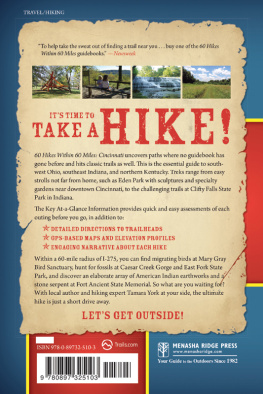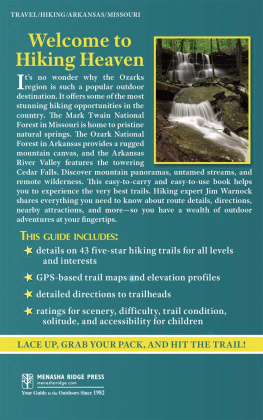ST. LOUIS: OVERVIEW MAP
MAP LEGEND

HIKE LIST


60 Hikes within 60 Miles: St. Louis
Copyright 2010 by Steve Henry
All rights reserved
Printed in the United States of America
Published by Menasha Ridge Press
Distributed by Publishers Group West
Third edition, first printing
Library of Congress Cataloging-in-Publication Data
Henry, Steve.
60 hikes within 60 miles, St. Louis: including Sullivan, Potosi, and Farmington/Steve Henry.3rd ed.
p. cm.
Includes bibliographical references.
ISBN-13: 978-0-89732-883-8 (alk. paper)
ISBN-10: 0-89732-883-3 (alk. paper)
1. HikingMissouriSt. Louis RegionGuidebooks. 2. St. Louis Region (Mo.)Guidebooks. I. Title. II. Title: Sixty hikes within sixty miles St. Louis.
GV199.42.M82S754 2010
796.510977856dc22
2010011154
Cover and text design by Steveco International
Cover photo copyright Steve Henry
Author by Glenn Hoffmeister
All other photos by Steve Henry
Maps by Steve Jones, Scott McGrew, and Steve Henry
Menasha Ridge Press
P.O. Box 43673
Birmingham, AL 35243
www.menasharidge.com
DISCLAIMER
This book is meant only as a guide to select trails in the St. Louis area and does not guarantee hiker safety in any wayyou hike at your own risk. Neither Menasha Ridge Press nor Steve Henry is liable for property loss or damage, personal injury, or death that result in any way from accessing or hiking the trails described in the following pages. Please be aware that hikers have been injured in the St. Louis area. Be especially cautious when walking on or near boulders, steep inclines, and drop-offs, and do not attempt to explore terrain that may be beyond your abilities. To help ensure an uneventful hike, please read carefully the introduction to this book, and perhaps get further safety information and guidance from other sources. Familiarize yourself thoroughly with the area you intend to visit before venturing out. Ask questions, and prepare for the unforeseen. Familiarize yourself with current weather reports, maps of the area you plan to visit, and any relevant park regulations.
THANKS TO ALL THE PARK FOLKS AND VOLUNTEERS WHO BUILT THESE SPECTACULAR TRAILS. MAY ALL WHO HIKE THESE PATHS APPRECIATE THE BEAUTIFUL RESULTS OF THEIR LABOR AS MUCH AS I DO.
DEDICATION
For my good friendsGlenn, who loved these trails, And Melissa, who misses him

ACKNOWLEDGMENTS
THANKS TO ALL THOSE WHO WORK AND VOLUNTEER IN THE PARKS , conservation departments, and national forests in the St. Louis area. Due to their vision and hard work, St. Louisans are blessed with miles and miles of beautiful trails only an hour or two from the metro area. Furthermore, theyre always happy to answer questionseven those from guidebook authors, wearing muddy boots and smelling kind of gamy, who barge into their offices five minutes before quitting time. Thanks also to the folks at Menasha Ridge Press, who were patient with me and somehow formed a mountain of material into a coherent and readable book. May our guidebook bring you miles of smiles in the hills, hollows, glades, and valleys of eastern Missouri and western Illinois.
Steve Henry
FOREWORD
Welcome to Menasha Ridge Presss 60 Hikes within 60 Miles , a series designed to provide hikers with information needed to find and hike the very best trails surrounding cities usually underserved by such guidebooks.
Our strategy is simple: First, find a hiker who knows the area and loves to hike. Second, ask that person to spend a year researching the most popular and very best trails around. And third, have that person describe each trail in terms of difficulty, scenery, condition, elevation change, and all other categories of information that are important to hikers. Pretend youve just completed a hike and met up with other hikers at the trailhead, we tell each author. Imagine their questions; be clear in your answers.
An experienced hiker and writer, author Steve Henry has selected 60 of the best hikes in and around the St. Louis metropolitan area, ranging from walks through the open meadows and marshes of August A. Busch Memorial Conservation Area to bushwhacking treks out to Greens Cave along the Meramec River. From urban hikes that make use of parklands to aerobic outings in national forests, Henry provides hikers (and walkers) with a great variety of hikesand all within roughly 60 miles of St. Louis.
Youll get more out of this book if you take a moment to read the Introduction that explains the trail profiles. The Topographic Maps section will help you understand how useful topos will be on a hike and will also tell you where to get them. And though this is a where-to, not a how-to guide, those of you who have not hiked extensively will find the Introduction of particular value.
As much for the opportunity to free the spirit as to free the body, let Steve Henrys hikes elevate you above the urban hurry.
All the best,
The Editors at Menasha Ridge Press
ABOUT THE AUTHOR

STEVE HENRY grew up on a farm in the rolling hills of central Kansas, spending much of his youth working under the blue skies of the plains. After earning bachelors degrees in marketing and agricultural economics at Kansas State University, he served a sentence of seven years in the offices of a large insurance company. Missing the outdoor life, he left the corporate world in 1985 to cycle across the continent twice, including one trek from Alaska to Key West. Since then he has led bicycle and backpack tours, contributed articles to outdoor publications and Web sites, and written Mountain Bike! The Ozarks and The Best in Tent Camping: Missouri and the Ozarks . He heads for the mountain and desert West whenever he can shake himself loose from the Midwest, and he always looks forward to fall and winter hiking, camping, biking, and canoeing in the Ozarks. When not roaming the outdoors by foot, bike, or canoe, Steve sees the country from the drivers seat of a Peterbilt 379.
PREFACE
ST. LOUISANS ARE SO LUCKY . There are miles and miles of trail in eastern Missouri and western Illinois, ranging from rugged all-day treks to short jaunts perfect for an evening walk. These trails explore a wide range of scenery, wandering through forests, river valleys, piney ridges, deep hollows, prairies, glades, wetlands, and several rugged canyons. Best of all, we Midwesterners can enjoy them year-round. When the glamour destinations in the western states are buried under feet of snow, we can still hit the trail.
In fact, winter is the favorite hiking season for many folks, including me. The forest is gray-brown, but bright cedars and pines stand out like green candles. Shorter days mean less time to hike, but the winter sunshine is deep and rich. The bugs are gone, theres no humidity, and the days are often autumn-like. The trees are bare, exposing scenic vistas obscured by greenery during the warm months. And bitterly cold weather means still more beauty. Waterfalls and streams freeze into fantastic ice sculptures, seeps from rock layers form icicle mustaches along cliff faces, and the snow squeaks pleasantly underfoot. After ice storms, the forest glitters as if encrusted with diamonds. The trees crack and groan in the wind, pelting you with tinkling showers of ice crystals as they shed their frozen jackets. And because lots of folks are intimidated by the cold, youll have all this beauty to yourself!



















